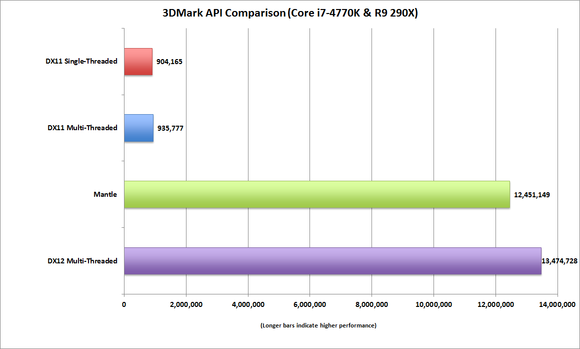Its no secret that AMD has been struggling a lot in recent years but change may be on the horison. Apart from the new 300 series GPUs that should be announced by June a lot has been going on on the API side of things. AMDs drivers are a well known, and contentious topic, in PC gaming circles but both DigitalFoundry and PCWorld have run a series of tests that show that AMDs DX11 drivers are indeed unoptimised. Combined with AMDs CPU shortcomings this puts a real dent on performance.
AMD must have been aware of this and responded with Mantle, a new API that reduced the amount of draw calls needed on the CPU. Few games used this feature but there was a definite performance advantage when employed. A few months later Microsoft announced DX12 which incorporated a lot of the design philosophies and aims of Mantle. Just like Mantle this results in significant boosts to performance. Both Digital Foundry at PC World go into greater detail below:
Digital Foundry:
http://www.eurogamer.net/articles/digitalfoundry-2015-why-directx-12-is-a-gamechanger
"In the here and how - in the era of DirectX 11 - life isn't particularly easy for AMD. Its problems in the CPU market are well documented. Its latest Bulldozer architecture bet the farm on numerous, slower cores in a world where DX11-driven gaming benefits more from fewer, faster cores, giving Intel an unassailable advantage. AMD still produces 32nm and 28nm processors, while Intel is now down to 14nm, giving it power efficiency advantages on top of its inherent performance improvements."
"The problems with AMD's DirectX 11 driver, amplified here with a draw call specific bench, are put into sharp relief. Firstly, not only is AMD's single-thread performance slower, but the driver is not multi-core aware whatsoever. Not only is Nvidia faster, but it can scale its load over three threads. The Core i5 - the processor with the fastest single-core performance in all of these tests - is the only chip capable of breaking the 1m draw call threshold on AMD hardware, somewhat vindicating our previous contention that enthusiast-level GPUs require an Intel quad-core CPU to get the most out of them. By contrast, Nvidia gets equivalent draw call throughput on every CPU we tested.
There's an irony here: AMD's driver set-up works best on Intel hardware and flounders on its own processor architecture. Meanwhile, there's some intriguing scaling going on with Nvidia graphics hardware running on AMD's FX 8350. Remarkably, the results also suggest that Nvidia's driver is more much more suited to AMD CPUs than AMD graphics cards, particularly when it comes to scalability of lower-end Nvidia GPUs on the eight-core FX 8350."
"The leap in performance applies to both Mantle and DirectX 12, and we happily noted that AMD's DX12 showing actually shows a significant improvement over Mantle (its own API, remember) in every test. Also worthy of comment is that AMD is highly competitive against Nvidia in all areas here - indeed, its lower-end GPUs actually process draw calls faster than their Nvidia equivalents. But the good news is that every piece of hardware we tested sees a boost courtesy of DX12 - we're seeing a far higher utilisation of both CPU and GPU. The figures demonstrate in particular how under-utilised the geometry engines are on our GPUs - what other areas of the graphics hardware are also under-utilised that DX12 could potentially access? The prospects are tantalising."
PCWorld
http://www.pcworld.com/article/2900814/tested-directx-12s-potential-performance-leap-is-insane.html
"As you can see from the chart below, DirectX 11's single-threaded and multi-threaded performance is underwhelming, churning through roughly 900,000 draw calls before performance drops under 30 fps on the Gigabyte WindForce Radeon R9 290X card. Using AMD's Mantle, we see an incredible jump to 12.4 million draw calls per second.
Although it's difficult to actually say which actual API was developed first (I've read stories that said DirectX 12 has been in the works for numerous years, while others report AMD was likely the first to push it), this test at least shows the potential of both of the new APIs. DirectX 12, in fact, is even slightly more efficient, cranking out 13.4 million draw calls per second."

"The silicon elephant in the room is also AMD's FX series. Generally AMD CPUs are inferior to their Intel counterparts clock-for-clock. A quad-core Haswell CPU generally lumps up an "eight" core FX chip in the vast majority of performance tests. But that FX chip, though it uses shared cores, runs much closer to— and sometimes faster than—Haswell if the test is heavily multi-threaded. DirectX 12 may make AMD's often ignored FX parts hot again, since you can find an 8-core FX processor priced for as low as $153. "





















